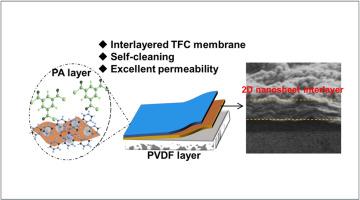Journal of Membrane Science ( IF 8.4 ) Pub Date : 2023-12-09 , DOI: 10.1016/j.memsci.2023.122328
Yingxin Zong , Qingwu Long , Liangwei Chen , Akbar Samadi , Huayong Luo , Kaiqiao Liang , Xiaodan Wan , Feng Liu , Yanwu Chen , Zhe Zhang , Shuaifei Zhao

|
Interlayered thin-film composite (TFC) membranes are promising in overcoming the permeability-selectivity tradeoff of conventional membranes. However, fabricating high-performance TFC membranes with tunable interlayer spacing and antifouling properties remains challenging. Here we develop a high-performance self-cleaning TFC graphene oxide (GO) membrane by employing multifunctional bismuthyl bromide (BiOBr) nanosheets to construct a unique photocatalytic GO@BiOBr interlayer. BiOBr has multiple functions, including regulating the GO nanosheet spacing (i.e., the channel size), mediating the surface properties of the interlayer to enable a desirable selective layer during interfacial polymerization, and imparting photocatalytic properties to the TFC membrane. Because of the dimensional difference between GO and BiOBr nanosheets, the spacing of the dual 2D nanosheets (GO and BiOBr) can be finely tailored by adjusting BiOBr loading. Coupling of the 2D nanosheets enables tunable interlayer properties and a highly thin and selective rejection layer, leading to significantly enhanced separation performance of the TFC membrane. The GO@BiOBr interlayered TFC membrane shows a water permeability of 29.9 L·m−2·h−1·bar−1, which is six times higher than the TFC membrane without an interlayer. The GO@BiOBr interlayered TFC membrane displays 100% rejections to various small molecules (e.g., Rhodamine B, Basic Blue 26 and Ofloxacin). The rise of BiOBr loading in the GO@BiOBr composite increases the interlayer spacing of the dual 2D nanosheets, likely leading to more monomer diffusion and eruptive interfacial polymerization. As a result, thicker and rougher polyamide layers are formed, resulting in decreased water permeability of the TFC membrane. This study presents a viable approach for engineering the next generation of high-performance self-cleaning TFC membranes for reverse osmosis, forward osmosis and nanofiltration within the realm of water treatment.
中文翻译:

具有可调层间距的双二维纳米片可实现高性能自清洁薄膜复合膜
层间薄膜复合(TFC)膜有望克服传统膜的渗透性-选择性权衡。然而,制造具有可调层间距和防污性能的高性能 TFC 膜仍然具有挑战性。在这里,我们通过采用多功能溴化铋(BiOBr)纳米片构建独特的光催化GO@BiOBr中间层,开发了一种高性能自清洁TFC氧化石墨烯(GO)膜。 BiOBr 具有多种功能,包括调节 GO 纳米片间距(即通道尺寸)、调节中间层的表面特性以在界面聚合过程中形成所需的选择性层,以及赋予 TFC 膜光催化特性。由于GO和BiOBr纳米片之间的尺寸差异,双二维纳米片(GO和BiOBr)的间距可以通过调整BiOBr负载来精细定制。二维纳米片的耦合可实现可调节的层间特性以及高度薄的选择性截留层,从而显着增强 TFC 膜的分离性能。 GO@BiOBr夹层TFC膜的透水率为29.9 L·m −2 ·h −1 ·bar −1 ,是TFC的6倍没有夹层的膜。 GO@BiOBr 夹层 TFC 膜对各种小分子(例如罗丹明 B、碱性蓝 26 和氧氟沙星)显示出 100% 的截留率。 GO@BiOBr 复合材料中 BiOBr 负载量的增加增加了双二维纳米片的层间距,可能导致更多的单体扩散和喷发界面聚合。结果,形成更厚且更粗糙的聚酰胺层,导致TFC膜的透水性降低。 这项研究提出了一种可行的方法,用于设计下一代高性能自清洁 TFC 膜,用于水处理领域的反渗透、正渗透和纳滤。































 京公网安备 11010802027423号
京公网安备 11010802027423号